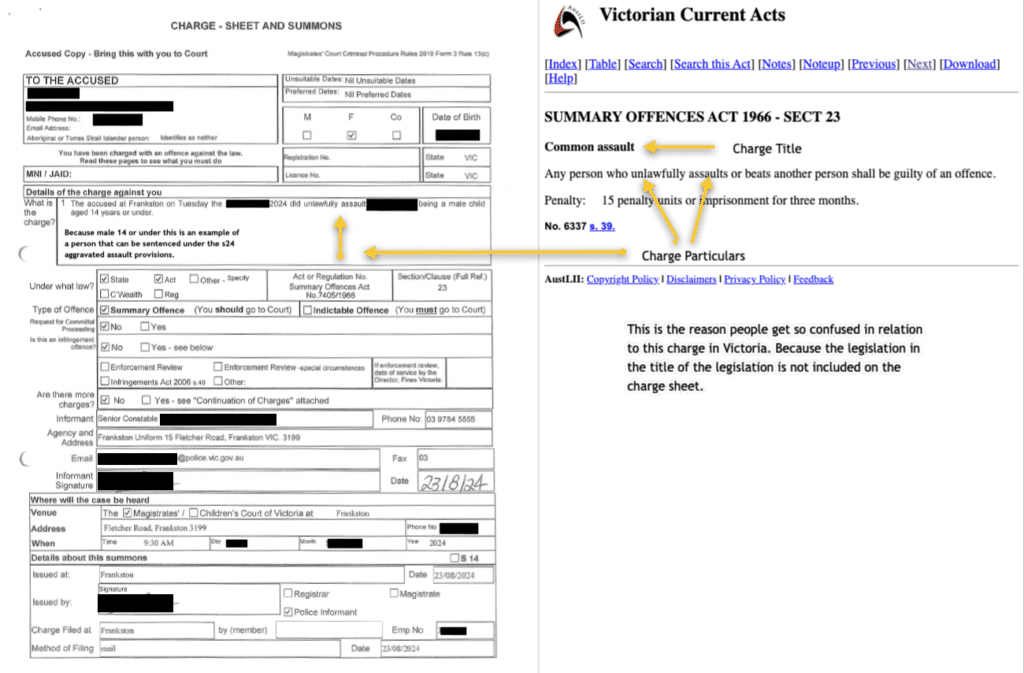Unlawful Assault Victoria
In Victoria, under section 23 of the Summary Offences Act 1966, any person who unlawfully assaults or beats another person is guilty of an offence liable to a maximum penalty of 15 penalty units or 3 months imprisonment. If found guilty you could be subject to a conviction, fines a community corrections or imprisonment.
If you’ve been charged with unlawful assault—also known as common assault in Victoria, contact one of our experienced lawyers to discuss your case.
The charge of unlawful assault is recognised criminally throughout all Australian states and territories. It involves intentionally or recklessly applying force or threatening force without consent or lawful excuse. The offence is tried summarily in Victoria, but can be indictable in the ACT, NSW, Queensland, and Tasmania. Each jurisdiction has specific statutes and penalties, reflecting the varying severity of assault offences, from unlawful assault to aggravated assault.
See the following interstate provisions for example:
- Criminal Code 1899 (Qld) s246 – An assault is unlawful and constitutes an offence unless it is authorised or justified or excused by law.
- Criminal Code Act 1983 (NT) s188(1) – Any person who unlawfully assaults another is guilty of an offence.
- Criminal Code Act Compilation Act 1913 (WA) s313 – Any person who unlawfully assaults another is guilty of a simple offence.
- Criminal Code Act 1924 (Tas) s184 – Any person who unlawfully assaults another is guilty of a crime.
- Crimes Act 1900 (NSW) s61 – Whosoever assaults any person, although not occasioning actual bodily harm, shall be liable to imprisonment for two years.
- Crimes Act 1900 (ACT) s26 – A person who assaults another person is guilty of an offence punishable, on conviction, by imprisonment for 2 years.
Unlawful Assault Summary Offences Act (Vic)
In Victoria the wording unlawful assault is found in the particulars of the charge, where there is usually reference to someone “unlawfully assaulting” a person, though the charge itself is formally titled common assault in the legislation. You can see this in the diagram of a typical charge sheet in Victoria. This distinction sometimes leads to misunderstandings amongst the public.
Unlawful assault is a summary offence and should not be confused with common law assault which is a distinct and more serious indictable offence with a higher maximum penalty. Additionally, unlawful assault under the Summary Offences Act is distinct from assault offences under the Crimes Act 1958, which are indictable charges and carry more severe penalties.
Many assault charges share the same elements, with more serious offences requiring an additional element, such as causing injury or serious injury to be proven. Because of this, police may file multiple assault charges for a single incident, such as unlawful assault, aggravated assault, common law assault or causing injury offences. In practice, some charges are often withdrawn in favour of alternative charges during the legal process.
Not all lawyers are well-versed in the differences between various assault charges, so it’s essential to work with only the best assault lawyer to help you achieve the desired outcome.
What is unlawful assault?
In Victoria, unlawful assault occurs when an individual intentionally or recklessly physically contacts another person or causes that person to apprehend or perceive immediate contact without consent or lawful excuse. Unlawful assault is liable to a maximum penalty of 15 penalty units or imprisonment for three months (Summary Offences Act 1966 s23).

Unlawful assault points of proof
To prove the offence of unlawful assault, the prosecution must prove beyond reasonable doubt that:
- The accused unlawfully assaulted or beat the complainant, that is:
- The accused applied force to the body of the complainant or caused the complainant to apprehend the immediate application of force to his or her body; and
- The accused intended his or her actions to cause such apprehension, or was reckless as to that outcome;
- The accused was aware the complainant was not consenting or might not be consenting; and
- The accused did so without lawful justification or excuse.
What types of actions might constitute an unlawful assault?
An assault is an intentional or reckless act that causes another person to apprehend or perceive immediate and unlawful physical contact (Fagan v Commissioner of Metropolitan Police [1969] 1 QB 439).
Case law indicates that the slightest touch to another person with the necessary intent is an assault, no matter how slight the interference (Cole v Turner (1704) 90 ER 958). Therefore, the application of force, even if the complainant is unaware of it, may be charged as assault.
In Victoria, for a contact to amount to an offence such as assault, there must generally be an intention to apply force or create the apprehension of force. For example, incidental physical contact, such as touching someone to get their attention, is not an offence if it lacks hostile intent, as established in Collins v Wilcock [1984] 1 WLR 1172.
To constitute an assault, it is necessary that the complainant perceives an immediate ability and intention by the accused to apply force. This principle is illustrated in Stephens v Myers (1830) 172 ER 735, which confirms that fear is not a required element for assault. For example, brandishing a firearm, even if unloaded or incapable of causing harm, may still amount to assault if it creates a perception of immediate threat, as seen in R v St George (1840) 173 ER 921.
However, where the complainant is unaware of the threat—such as a firearm being pointed from behind—there is no assault, as per Police v Greaves [1964] NZLR 295. In such cases, the physical application of force would instead constitute battery and, by extension, assault, as explained in Jones v Sherwood [1942] 1 KB 127.
Likely penalty regarding unlawful assault?
The maximum penalty for unlawful assault is 15 penalty units or up to three months imprisonment, as specified in section 23 of the Summary Offences Act 1966.
If the court finds that there are any circumstances that would aggravate the unlawful assault to an aggravated assault, then higher maximum penalties apply. See the aggravated assault for more information.
Where unlawful assault is heard
In Victoria, unlawful assault is classified as a summary offence, with the ability to move it to higher courts under section 242 of the Criminal Procedure Act 2009 (Vic) to be considered alongside indictable charges. Otherwise, unlawful assault is heard exclusively in the Magistrates Court of Victoria.
What to do next
If you have been charged with unlawful assault, it is crucial to seek immediate legal advice. Our firm can assist you by preparing a comprehensive defence strategy, including gathering necessary reports and documents, to reduce your sentence or achieve the most favourable outcome possible.
Should you decide to plead not guilty, we urge you to contact us without delay so we can develop an effective case strategy. Our specialist assault lawyers will thoroughly examine all evidence, including CCTV footage, DNA evidence, and witness statements while safeguarding any evidence that may exonerate you.
There are two very important questions to consider with your lawyer:
- Can the prosecution prove the charge against you?
- If you are found guilty or if the answer to the first question is the prosecution can prove the charge against you, what can be done to minimise the penalty that is imposed.
It’s advisable to discuss your options with an experienced criminal lawyer as soon as possible.
Prompt action and strategic legal guidance significantly enhance the likelihood of charge dismissal or acquittal. Do not postpone your legal preparation; diligent and timely planning is critical to securing a positive result.
Unlawful assault legislation
Section 23 of the Summary Offences Act 1966
Any person who unlawfully assaults or beats another person shall be guilty of an offence.
Penalty: 15 penalty units or imprisonment for three months.

























